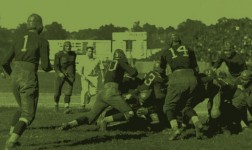By: Jordan Sperber
Given that prior research has established that scheduling quality opponents is among the factors positively correlated with tournament selection and success, this article observes the practical considerations for nonconference scheduling in two areas: program budgets and program prestige.
This approach explicitly recognizes that coaches must balance the opposing forces of (a) scheduling winnable games and (b) scheduling quality opponents. The inherent trade-off tends to naturally create two contrasting groups of teams. The college basketball version of the “chicken and egg” may just be: Successful team A with a weak schedule or not-as-successful team B with a strong schedule. Table 1 shows the most widely accepted bubble teams from 2012 according to The Bracket Matrix. The y-axis is strength of schedule (via kenpom.com) and the x-axis is win percentage.
Table 1 – Bubble Teams: SoS vs. win%
Of course, coaches can only influence their non-conference schedules. 1 This puts a team like Iona (shown above) at a potential disadvantage, as a majority of their schedule is against relatively weak in-conference opponents. As you can see, Drexel had the best winning percentage of any bubble team but did not get selected by the committee, which was probably due to a weak nonconference schedule.
With this background in mind, this article offers a lens to see the interplay between program budgets and prestige on non conference scheduling by using a sample of three teams for two categories of teams: majors and mid-majors.
Table 2 – Two “Tiers” of Teams and Their Athletic Department Budgets*
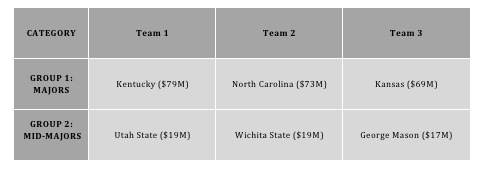
Dollar amount in parenthesis is school’s 2009-2010 Athletic Department expenses form Win Ad’s Financial Database
Using the above categories and Win AD’s exclusive data, we analyze the nonconference scheduling from the 2009-2010 season for each of the above 6 teams set forth in Table 2.
Group 1: “Majors”
Let’s start with the powerhouse programs. Because they play plenty of quality opponents in-conference, scheduling tough nonconference opponents isn’t necessarily a priority.
Table 3 – “Majors” Scheduling Overview
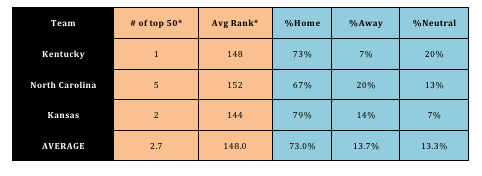
*Opponent’s ranks from kenpom.com
Table 3 aligns with common sense. Each team played a nonconference schedule full of home games. UNC played an extremely difficult schedule. A team like UNC has the luxury of playing other elite teams either on a neutral court or in a home and home situation. Top teams often have little to gain and much to lose by traveling to play mid-majors.
Table 4 – “Majors” Guarantee Games Expenditures & Compensation
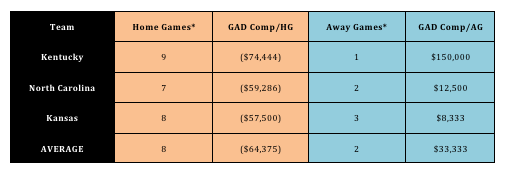
*Number of home and away games only included games in Win AD’s Financial Database.
On average, these three teams paid their opponents $64,375 per game to play on the road during the 2010-2011 season, according to Win AD’s Guarantee’s Database 2
Group 2: “Mid-Majors”
The teams in this tier are fairly commonly sitting on the bubble come March. Thus, every game they have played is dissected by the committee. This makes nonconference scheduling crucial. However, they face multiple obstacles in putting together a quality schedule. First, the budgets of these schools are limited, inhibiting their ability to pay higher guarantee game fees. In fact, the expenses of these schools are much closer to low mid-majors ( a third tier, below mid-majors) than major powerhouses. Thus, these schools can have difficulty getting quality top tier schools to commit to home and home series.
In order to play “top tier” teams, these mid-majors must be willing to go on the road and not receive a return game the following year. Utah State head coach Stew Morrill is well known for being unwilling to do this, only once has he given in and played at Georgetown during the 2010-2011 season. Table 5 takes a deeper look at the mid major schools selected for this article.
Table 5 – Mid Major Scheduling Overview
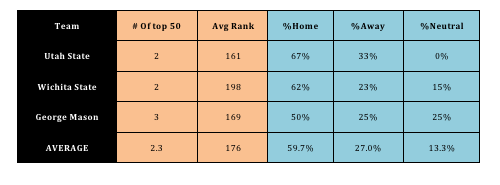
*Opponent’s ranks from kenpom.com
At first glance in Table 5, it might be somewhat surprising that these three teams still played the majority of their nonconference games at home in 2010. However, the problem isn’t getting teams to come travel and play. The problem is getting top teams to come. Overall, this tier of teams played the weakest schedules according to kenpom rankings.
Table 6 – “Mid-Majors” Guarantee Games Expenditures & Compensation
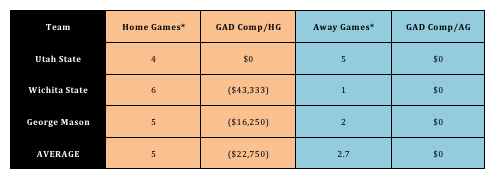
*Number of home and away games only included games in Win AD’s Guarantee Games Database
Table 6 shows the differences between majors and mid-majors. These mid-majors compensate their opponents on average $22,750 per home game (according to Win AD’s Guarantee Games database), which is much smaller than the national powerhouses – see Table 4. For away games, none of these teams were compensated at all. 3
Conclusion
At the mid major level, non-conference scheduling is no easy task. A cohesive, data driven strategy is needed to balance strength of schedule and winnable games. Though scheduling can be a challenging task, dictated partially by opportunity and timing, there are ample top tier programs willing to schedule home and home series, and ADs need visibility of those programs and market data, to optimize their scheduling decisions.
Win AD gives special thanks to Jordan Sperber.Jordan began writing about college basketball using statistics at Hoop Vision as an 11th grader in high school. Now he is entering his second year at Villanova University, where he plans to major in management information systems with a minor in business analytics.
References:
- Kentucky coach John Calipari has been outspoken about his new scheduling philosophy, which favors neutral-site battles in huge arenas. But Kentucky is Kentucky and can dictate its scheduling needs. ↩
- Indiana paid Kentucky $150,000 for its trip to Bloomington, but other than that outlier, these schools were minimally compensated for their road games. ↩
- We note that Utah State does have special circumstances. The program plays each Utah team every year as a tradition (and for this distinction), which does give Utah State less control to an extent. ↩




